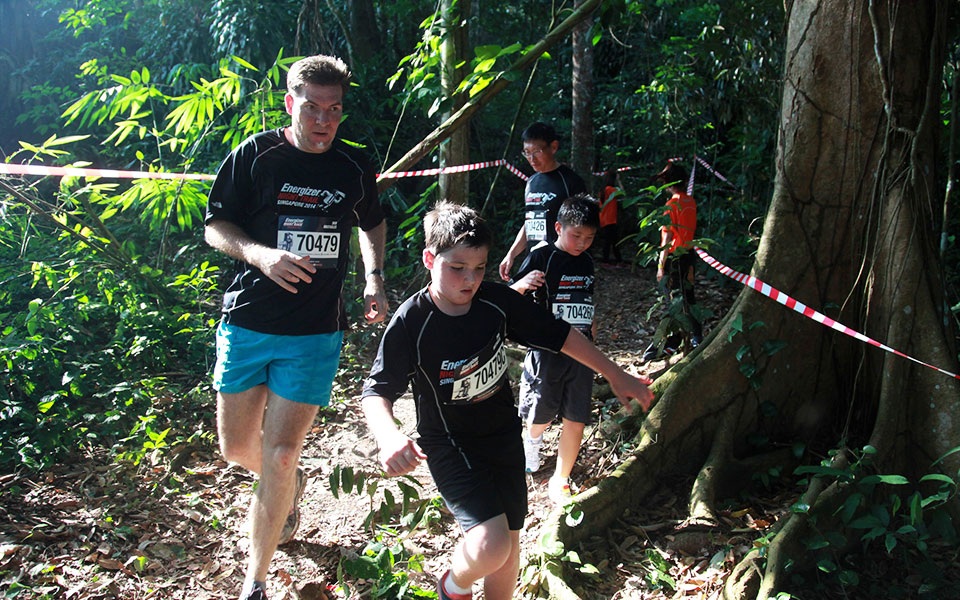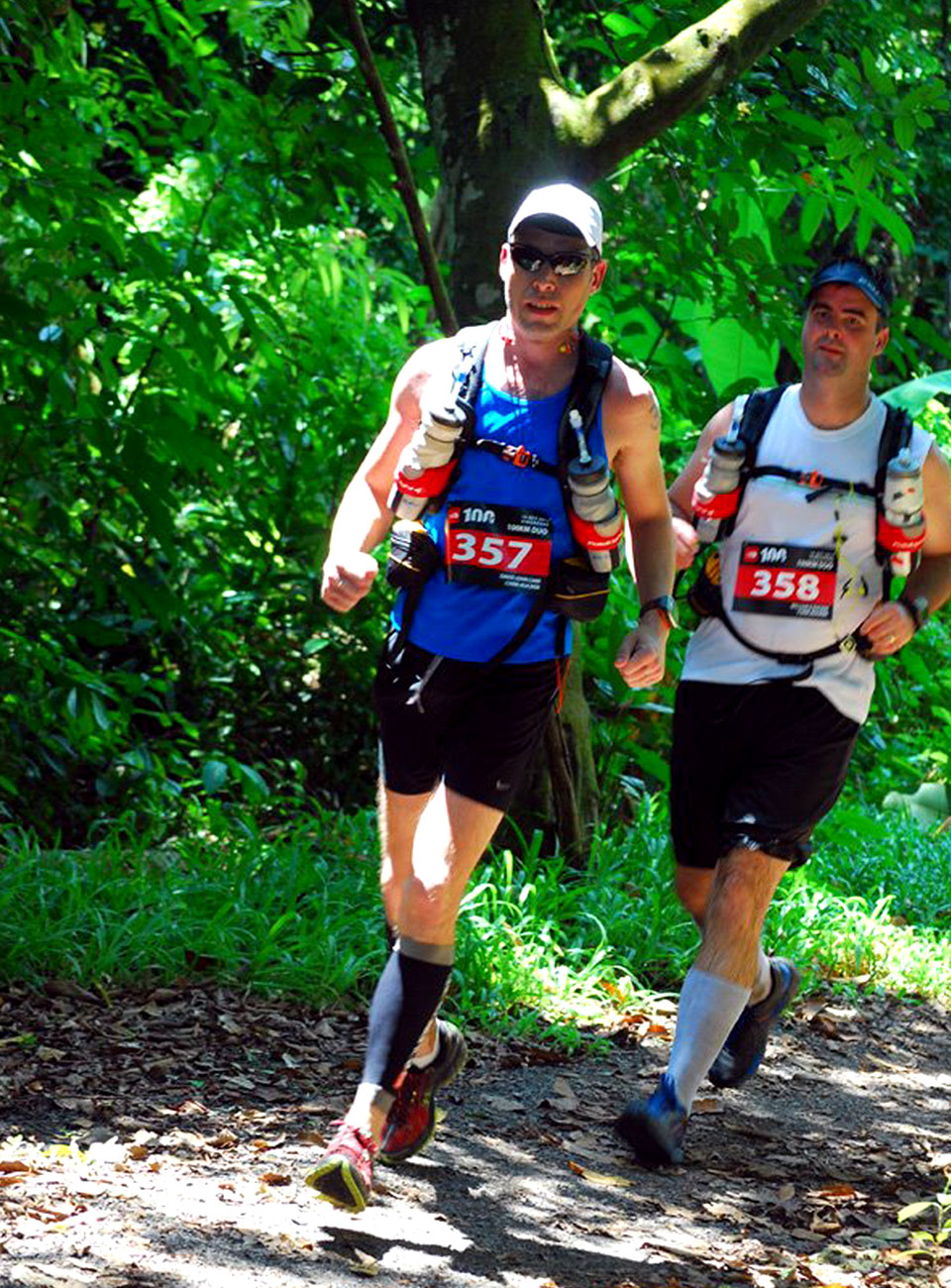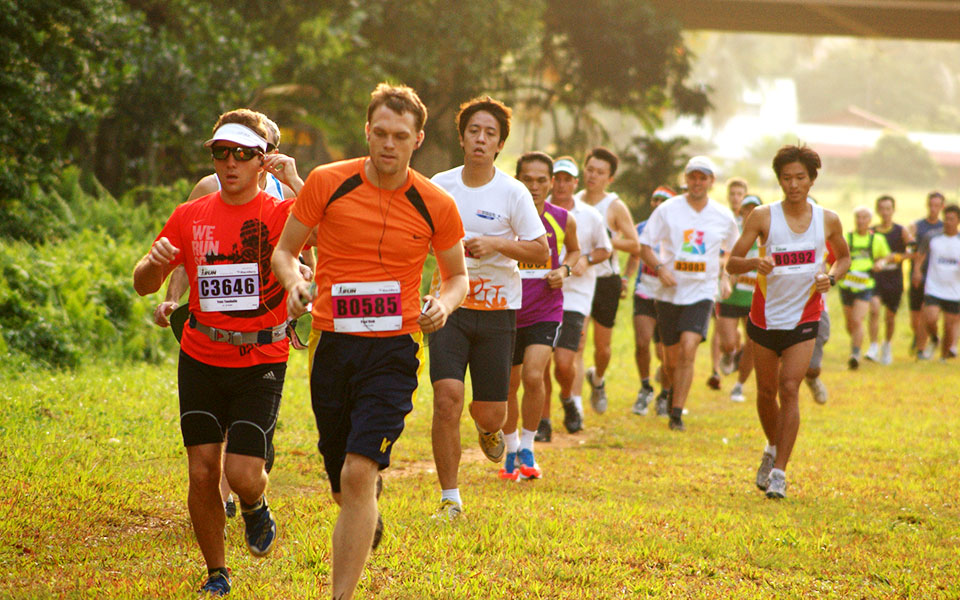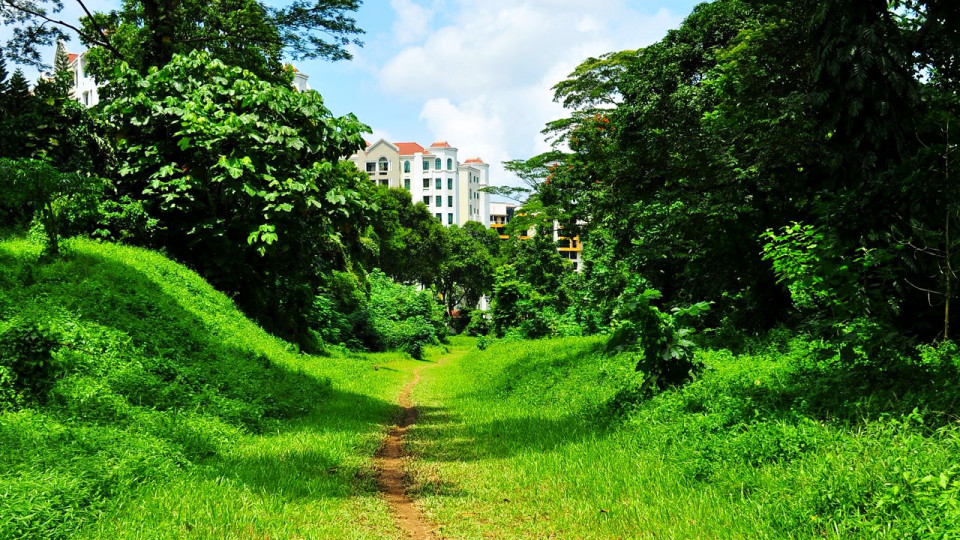Close your eyes and imagine this with me. You’re hurtling downhill, surefooted like a mountain goat. Rocks, roots, steps, mud, nothing gets in your way. Suddenly the path ahead curves steeply up, beyond your line of sight. You shorten your stride and bump up your cadence, in effect ‘cycling’ up the hill in front of you. All the while, far removed from the concrete, traffic and pollution of the city. Just you, your feet, and the constant rhythm of your own breathing.
This is the essence of trail running.
It’s little wonder that there’s been a huge surge in interest with regard to trail running. There is a primal elegance to running wild in nature, which cannot be gained out on the road or track. It’s a return to the simple ways of our forebears, the persistence hunters who caught their food by basically running it to death (read Christopher McDougall’s brilliant Born to Run to find out more if you haven’t). No internet, no crowded MRT, nobody except your fellow crazies – trail running is the ultimate easy-access escape in our fast-paced insane world. Of course, if this “zen” was all one could gain from trail running, people would probably choose meditation instead. There’s a whole lot more to be had from getting off the beaten path.
Why Trail?
Our bodies learn and grow stronger by being challenged regularly. Running enough of the same 400m loop at your neighbourhood stadium track will eventually get your 2.4 timing into IPPT Gold territory, but you’ll be hard pressed to do much else. Add in a few longer runs at a park nearby, and you’ll start to see improvement. Throw in a few stairs sessions, and you’ll soon be the envy of everyone else back at your stadium loop. That’s a lot of concrete to pound, and with too much you could easily end up with a stress fracture! However if you do this gradually with care, you’ll be rewarded with stronger legs, better cardiovascular function and the running form of an elite.
Take all of those benefits, combine them with even more strength-building hills, varied terrain to strengthen ankles and knees further, and a low-impact surface to keep your joints happy, and you may just find yourself reaching for your trail shoes. Adding a trail workout to your weekly routine will make you a stronger, better runner, while also paving the way to fewer future injuries. Switching over to trails most of the time or entirely will do you even more good, although this is admittedly hard in cities like Singapore. Personally, I have found that shifting focus to trail running has indeed made running easier. By dedicating weekdays to training for elevation, and weekends to long trail jaunts, I’ve largely been able to avoid injuries and accidents despite putting in a much greater training volume than usual.

Many of us run not just for fitness, but because we find it helps clear our minds and puts us in a better mood (thank you endorphins). This too is personal experience, but I have found trail running to bring me to a more meditative state than running on the road does. Perhaps it’s the isolation or perhaps it’s the natural surroundings; regardless, it seems to help me mentally reach that ‘autopilot’ state which we crave as runners, where everything just goes by smoothly. Many of my friends who are trail runners or have dabbled in it agree that this is the case too!
Finally, the ultra running scene has become closely associated with trail running, and a large number of ultra races (those longer than a marathon, or over 42km in length) tend to be on trails. In a way, these two sub-genres of running go well together, with the lower impact trails, ever-changing natural surroundings and challenging climbs lending themselves well to the suffering of ultra distances.
Trail Gear – Minimalist or Overkill
Running can be a really low-cost hobby; all you really need is a pair of running shoes and enough clothing to keep you from getting arrested. Trail running is similar, but the more entrenched you become in it as a sport, the more tempting specialised gear becomes. The first piece of gear that you’ll probably be drawn to that’s trail specific is a pair of trail shoes. These differ from your regular road shoes by having lugged, grippy outsoles and more durable construction overall. Some trail shoes feature gaiter attachments, waterproofing, and designs specifically geared to certain terrain (e.g. deep lugs for mud/snow, “maximalist” shoes with huge cushioned outsoles for comfort over long distances). Popular shoe brands include Salomon, The North Face and La Sportiva, but most major running shoe companies make trail-specific shoes too (both Nike and Mizuno have really strong contenders for best trail shoe in my book).
Venturing into the ultra running scene, or really anywhere beyond 10km, many of us start to accumulate enough gear to start a small store. Here’s a non-exhaustive list of things that trail runners tend to gravitate towards:
- Specialised trail running clothing and compression
- A GPS watch with decent battery life
- Hydration packs (either with bladders or bottles) and handhelds
- Headlamps for running at night
- Trekking poles for tough climbs
- On-the-go nutrition like gels, bars, powders and electrolyte pills
- Headgear like the ubiquitous Buff
- Waterproof bags for carrying phones and cash/EZ Link cards
- Layers of running clothing for colder overseas races
- Dry bags to use at drop points
- Friends and family who will spend hours (and sometimes days!) cheering for you

Where
As a mostly flat city which has undergone extensive development, Singapore is not exactly a trail runners’ paradise. You are never really removed from civilisation, which some say is a critical part of the mental aspect of trail running. The humidity and temperature don’t help much either. However, there are still options for those who seek them, and Singapore is a great place to first get into trail running, with much easier terrain than you’d find in neighbouring countries. A popular and central starting point is Macritchie Reservoir Park, where you have an approximately 10km loop, which you can optionally extend to about 14km, or shorten to about 4km. You get decent elevation and a variety of trail conditions, from rocks and wider ‘roads’ to singletrack. Bukit Timah Nature Reserve used to be an option, but it is currently undergoing trail restoration. The Green Corridor runs from Tanjong Pagar to Woodlands, and provides a great flat, straight trail for speedwork. Interestingly, the Green Corridor also connects most of the major trail training areas to each other. For the more adventurous of us, there are a few more options, such as the Pipeline Trail, Mandai T15, Durian Loop, Dairy Farm Nature Park and, my own favourite (and arguably the most scenic trail), Butterfly Trail (which is sadly closed until June 2016).
The great thing about being a trail runner in Singapore is the accessibility of overseas races. As a major global transport hub, challenging races are no more than a quick flight away. Nearby countries lend themselves well to different kinds of races;
- Hong Kong – Huge climbs, lots of stairs, technical races on well-maintained but narrow trails all across the island. Great city for trail running because you’re never more than 30 minutes from a trail head wherever you are. Great weather during the running season, with temperatures usually below 20°C, and low humidity.
- Taiwan – Well-developed ultra scene with lots of similarities to Hong Kong. Less well-known in terms of major races, yet extremely scenic. Interestingly, there are many races in both Hong Kong and Taiwan that are “sister races” of sorts (e.g. the Action Asia events and the North Face series)
- Australia – Lots of trail races throughout the year, with ultras and shorter races available. Varied terrain and can be challenging with much more extreme weather.
- Malaysia – Best known for long distance jungle races, multi-day stage races and adventure races, prepare for similar weather to Singapore, with more climbs and more humidity
- Indonesia – Probably the nearest high-altitude mountain racing for Singaporeans! Lots of long tough races (Mount Rinjani Ultra, Bromo-Tengger-Semeru Ultra) with gut-busting climbs and huge terrain variations. Fast-growing ultrarunning scene and you could very well race a whole year in Indonesia and not get bored.
- Thailand – A relative newcomer to the trail/ultra world, there are a lot of interesting races being added in Thailand, and with it’s tourist-friendly infrastructure and large swathes of undisturbed terrain, it could soon be a competitor regionally for jungle racing.
- Japan – A trail runner’s dream come true; mountains everywhere, well maintained trails, and an ingrained culture of being connected to nature. Lots of big races, including what may be the toughest trail race in Asia, the Ultra Trail Mount Fuji.
Trail running is also fast becoming the next big thing in the rest of Asia, and it’s exciting to see great races being put together in the Philippines, India, China, and so many other areas. For those of us with deeper pockets or lots of airline miles, Europe and the US have really strong trail running culture, and certain parts of South America have some of the most beautiful scenic trails known to man.
When
With the wealth of options regionally, there is no real ‘season’ for trail running in Asia. The main thing to take note of in Singapore is the rain; when it’s the wet season, prepare to get muddy. Regionally, temperatures vary more and further afield such as in Japan, you may encounter snow. There are certain anchor races that happen more or less around the same time every year. Locally, The North Face 100 tends to be around October, while the Energizer Night Trail and Green Corridor Run tend to be in the middle of the year. The MR 25 running club regularly hold races at Macritchie, while smaller independently organised races happen all throughout the year. Translantau and the Hong Kong 100, popular trail races in Hong Kong, happen at the beginning of the year.
The growth of trail running is becoming more apparent in Singapore, with the Salomon X-trail Race moving to a new location in Punggol, and the addition of two all new trail ultramarathons. The The Great Relay Singapore (June) and MSIG Action Asia 50 (July) are both organised by big names in the regional trail scene, and one can only hope that both races return in the middle of next year for trail runners.

Let’s go
Trail running is arguably running in it’s purest form, distilled to it’s very essence. It’s a great way to become a stronger, better runner while avoiding injury, and you will be surprised by how relaxing it can be to be outdoors reconnecting with your inner animal. Though Singapore is flatter than some trail runners may like, it does present some interesting local options, and more importantly, it is a great home base to travel to regional races. So what are you waiting for? Lace up your trail shoes, grab your stuff, and head out to the forest. Nature is calling.





